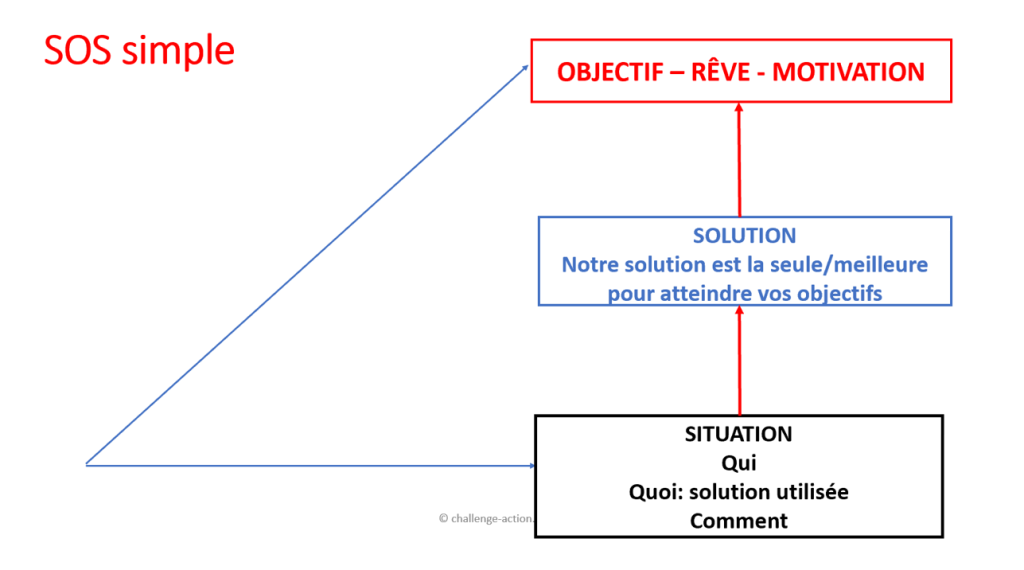SOS sales technique
Salespeople realized that it was easier to sell to customers with a problem than to those without. This led to the development of techniques such as SPIN, which are based on the customer’s problem, the aim of which is to increase perception by asking about the consequences for the customer. The difficulty is that many […]
Salespeople realized that it was easier to sell to customers with a problem than to those without. This led to the development of techniques such as SPIN, which are based on the customer’s problem, the aim of which is to increase perception by asking about the consequences for the customer. The difficulty is that many people don’t like to be told they have problems, especially by a stranger, let alone a salesperson.
The SOS sales technique has the enormous advantage over many other sales techniques of making the customer see the problem without talking about it, and focusing on his dreams.
The SOS sales technique
Situation
Objective
Solution
A problem is in fact a gap between a current situation and a desired situation, which we call “Objective”.
The technique is based on three key principles:
- Customers are always more likely to believe what they say than what we tell them, so we make them say things, but in a structured way.
- A dream or a project is more salesy and positive than a problem and its consequences, which is why it’s a good idea to end with the interviewer’s objectives.
- Once the customer wants something better than what he currently has, he’s ripe for a solution, but it’s best not to ask him what it is, as he’s likely to ask for a solution that we can’t offer. Here, the salesperson plays his role as advisor.

How to apply the sales technique
The idea is to ask questions in a structured way, while remaining customer-focused, starting with open-ended questions and ending with closed-ended ones, but at the customer’s pace.
The logical order would normally be to start with the situation and then move on to the customer’s objectives, before proposing the solution. But in a store, the order is reversed: the customer arrives asking for a product, and it’s the sales assistant’s job to ask what it’s going to be used for, i.e. the customer’s objective. Basically, the key is to create a gap, regardless of the order of the discussion.
Situation questions
Situational questions depend on the profession you are without, but can revolve around this:
- You
- Your family
- Your financial situation
- What you like about the current situation and what you don’t.
Questions about the objective
It is not always necessary to ask them, as the customer will often give them themselves, but here are some examples:
- What’s your objective?
- What’s your dream?
- What would be your ideal?
- What would you like to benefit from?
It’s at the level of the objective that we place the customer’s motivations, which we’ve discovered through SONCAS or SEC.
The difficulty arises when a customer feels that he’s happy with his situation and that there’s nothing to improve. It’s then up to the salesperson to try to show that he can have better and to try to create a gap by asking the customer if he could still have better, what his ideal situation would be.
Questions about the solution should be avoided, unless you’re proposing tailor-made solutions that you can adapt as you see fit. In all cases, the customer continues to play an advisory role.
Examples of SOS techniques
In the financial sector
- Situation :
- What is your personal situation? Family?
- Where do you work?
- Your financial situation?
- Objectif :
- What are your plans?
- Your dreams?
- Your retirement dreams?
Beauty products sector, skin cream
- Situation :
- how does your skin feel at the end of the day?
- What kind of environment do you work in? Too dry? Too cold?
- Partez en vacances au soleil bientôt ?
- What is your current skincare routine?
- Objective
- What would be your dream?
- If I had a magic wand, what would you like to look like?
SOS sales technique, conclusion
The SOS sales technique is simple, effective and positive, while at the same time being able to play on the contrast between the current situation and the ideal situation. It’s the best sales technique if you know how to use it well.
It can also be broken down into several variants, such as the SOS global solution and the SOSAI in the event of competition and the need to compare solutions.
Jean-Pierre Mercier
